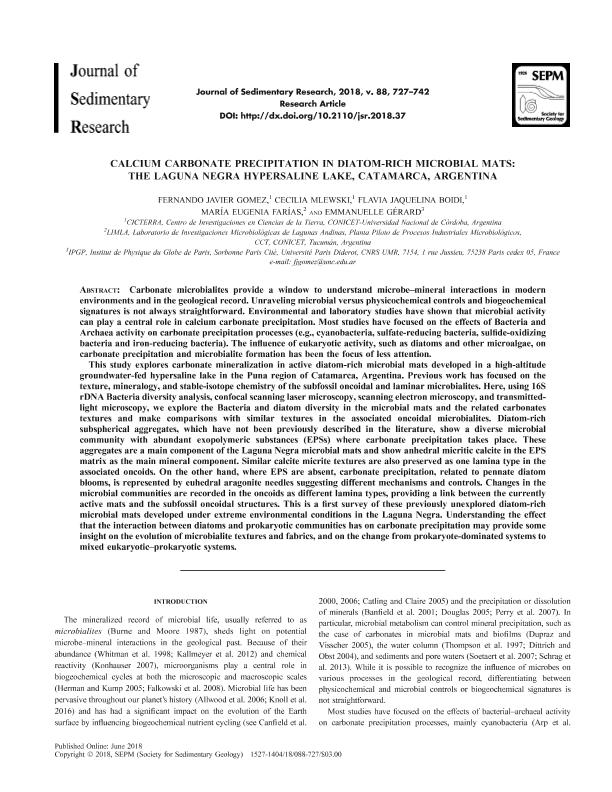Artículo
Calcium carbonate precipitation in diatom-rich microbial mats: The Laguna Negra hypersaline lake, Catamarca, Argentina
Gomez, Fernando Javier ; Mlewski, Estela Cecilia
; Mlewski, Estela Cecilia ; Boidi, Flavia Jaquelina
; Boidi, Flavia Jaquelina ; Farias, Maria Eugenia
; Farias, Maria Eugenia ; Gérard, Emmanuelle
; Gérard, Emmanuelle
 ; Mlewski, Estela Cecilia
; Mlewski, Estela Cecilia ; Boidi, Flavia Jaquelina
; Boidi, Flavia Jaquelina ; Farias, Maria Eugenia
; Farias, Maria Eugenia ; Gérard, Emmanuelle
; Gérard, Emmanuelle
Fecha de publicación:
06/2018
Editorial:
Society for Sedimentary Geology
Revista:
Journal of Sedimentary Research - (Print)
ISSN:
1527-1404
Idioma:
Inglés
Tipo de recurso:
Artículo publicado
Clasificación temática:
Resumen
Carbonate microbialites provide a window to understand microbe-mineral interactions in modern environments and in the geological record. Unraveling microbial versus physicochemical controls and biogeochemical signatures is not always straightforward. Environmental and laboratory studies have shown that microbial activity can play a central role in calcium carbonate precipitation. Most studies have focused on the effects of Bacteria and Archaea activity on carbonate precipitation processes (e.g., cyanobacteria, sulfate-reducing bacteria, sulfide-oxidizing bacteria and iron-reducing bacteria). The influence of eukaryotic activity, such as diatoms and other microalgae, on carbonate precipitation and microbialite formation has been the focus of less attention. This study explores carbonate mineralization in active diatom-rich microbial mats developed in a high-Altitude groundwater-fed hypersaline lake in the Puna region of Catamarca, Argentina. Previous work has focused on the texture, mineralogy, and stable-isotope chemistry of the subfossil oncoidal and laminar microbialites. Here, using 16S rDNA Bacteria diversity analysis, confocal scanning laser microscopy, scanning electron microscopy, and transmittedlight microscopy, we explore the Bacteria and diatom diversity in the microbial mats and the related carbonates textures and make comparisons with similar textures in the associated oncoidal microbialites. Diatom-rich subspherical aggregates, which have not been previously described in the literature, show a diverse microbial community with abundant exopolymeric substances (EPSs) where carbonate precipitation takes place. These aggregates are a main component of the Laguna Negra microbial mats and show anhedral micritic calcite in the EPS matrix as the main mineral component. Similar calcite micrite textures are also preserved as one lamina type in the associated oncoids. On the other hand, where EPS are absent, carbonate precipitation, related to pennate diatom blooms, is represented by euhedral aragonite needles suggesting different mechanisms and controls. Changes in the microbial communities are recorded in the oncoids as different lamina types, providing a link between the currently active mats and the subfossil oncoidal structures. This is a first survey of these previously unexplored diatom-rich microbial mats developed under extreme environmental conditions in the Laguna Negra. Understanding the effect that the interaction between diatoms and prokaryotic communities has on carbonate precipitation may provide some insight on the evolution of microbialite textures and fabrics, and on the change from prokaryote-dominated systems to mixed eukaryotic-prokaryotic systems.
Palabras clave:
CALCIUM CARBONATE
,
DIATOMS
,
HYPERSALINE LAKE
,
MICROBIALITES
Archivos asociados
Licencia
Identificadores
Colecciones
Articulos(CICTERRA)
Articulos de CENTRO DE INVEST.EN CS.DE LA TIERRA
Articulos de CENTRO DE INVEST.EN CS.DE LA TIERRA
Articulos(PROIMI)
Articulos de PLANTA PILOTO DE PROC.IND.MICROBIOLOGICOS (I)
Articulos de PLANTA PILOTO DE PROC.IND.MICROBIOLOGICOS (I)
Citación
Gomez, Fernando Javier; Mlewski, Estela Cecilia; Boidi, Flavia Jaquelina; Farias, Maria Eugenia; Gérard, Emmanuelle; Calcium carbonate precipitation in diatom-rich microbial mats: The Laguna Negra hypersaline lake, Catamarca, Argentina; Society for Sedimentary Geology; Journal of Sedimentary Research - (Print); 88; 6; 6-2018; 727-742
Compartir
Altmétricas



